The iPhone 4 Redux: Analyzing Apple's iOS 4.0.1 Signal Fix & Antenna Issue
by Brian Klug & Anand Lal Shimpi on July 15, 2010 12:28 PM EST- Posted in
- Smartphones
- Apple
- iOS 4
- iPhone 4
- Mobile
Better at the Low End, Mixed Feelings Everywhere Else
Brian came up with the plan to enable the numerical signal strength visualization and executed on it very well in our original iPhone 4 review. Since then there’s been a disturbing amount of debate as to whether or not this actually amounts to a problem with the phone.
Part of the confusion stems from the fact that doing this sort of antenna testing in a real world scenario is time intensive. As Brian mentioned on the previous page, for today’s article both of us were driving around our respective cities, stopping at various locations, measuring signal strength and comparing it to bar mappings in order to produce the charts you saw on the other page.
There’s no denying that Apple has played a significant role in why there continues to be debate about the iPhone 4 antenna. By simply addressing the pre-4.0.1 bars not being a good representation of signal strength and ignoring the fact that the iPhone 4 does lose more signal strength than competing phones depending on how you hold it, Apple manages to convince its faithful that there’s nothing wrong while driving its critics to demand a recall.
My mother always taught me that honesty is the best policy and presumably I’m not the only one in the world who was privy to this information. Had Apple come clean with both of these facts (the bar mapping and the signal attenuation issue) early on we’d be in a far more clear cut world today.
We have consistently argued that the 4’s antenna is a design choice by Apple. As we’ve seen in our testing there are situations where the iPhone 4’s antenna makes things better (e.g. holding onto calls with very low signal strength) and other situations where the design makes them worse (e.g. holding it wrong in situations with low signal strength). I wanted to describe the inconsistency in greater detail so I went out with an iPhone 3GS and 4 and documented my experiences.
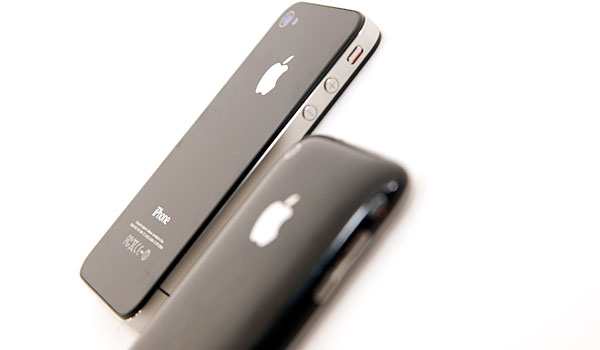
In practice I found three things that were true about the iPhone 4’s antenna behavior compared to the 3GS.
Reception in average conditions is sometimes significantly better on the iPhone 4 than on the 3GS. Take a look at the image capture below. In the same exact location we have better reception on the 4 than the 3GS. Granted this could be due to a number of variables outside of the phone’s antenna itself, but it happened enough times that it’s worth reporting. This is the positive to Apple’s external antenna design - you can and do get better reception. Unfortunately the tradeoff is the scenario I just described before this.
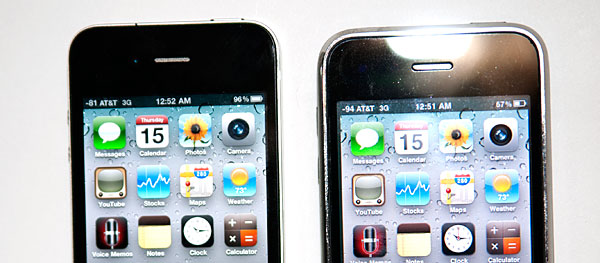
iPhone 4 (left) at -81 dBm vs. iPhone 3GS (right) at -94 dBm
Signal strength is sometimes the same as or worse than the iPhone 3GS. This is really where the problem comes into play. In the shot below I have the 4 and 3GS sitting next to one another and they are displaying roughly the same signal strength. We’ve already proven that holding the iPhone 4 attenuates its signal more than the 3GS, which results in the frustration we’ve seen expressed by many at this point. In situations where the 4 has the same signal as the 3GS, holding the phone is going to drop it to levels significantly worse than the 3GS. If you’re in an area with low signal strength to begin with, holding the phone is going to bring you down to dangerously low levels.
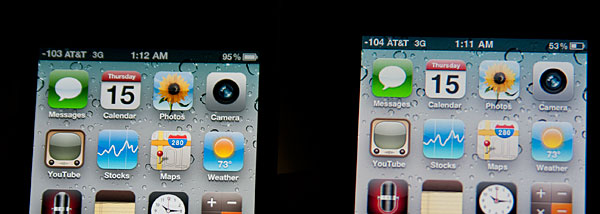
iPhone 4 (left) at -103 dBm vs. iPhone 3GS (right) at -104 dBm
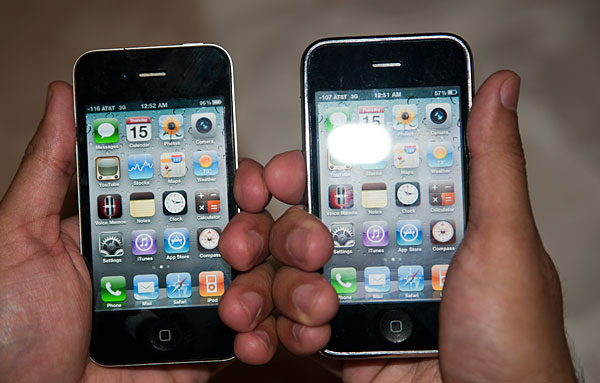
iPhone 4 being held tightly (left) at -115 dBm vs. iPhone 3GS being held tightly (right) at -107 dBm
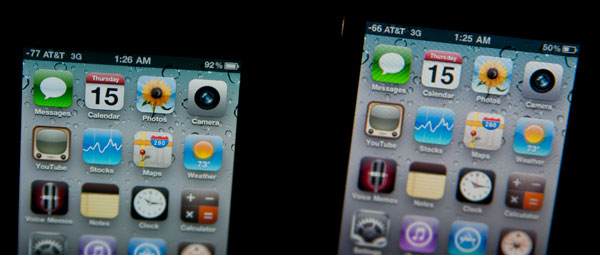
iPhone 4 (left) at -77 dBm vs. iPhone 3GS (right) at -66 dBm
The iPhone 4 is better at holding onto calls and data at very low signal levels. We’ve mentioned this one before but it’s worth reiterating. The new antenna does let me make calls and transmit data at very low signal strength. With the iOS 4.0.1 update I was able to make a call at -115dB on the 3GS, however the call did drop within a minute of starting it. By comparison I was able to have a much longer conversation without dropping the call at -120dB on the 4. By no means is this a scientific comparison, but anecdotally both Brian and I feel that the low signal strength performance of the iPhone 4 is better than the 3GS.

A call at -120 dBm on the iPhone 4
If you’re keeping tabs you’ll note that this is what is traditionally referred to as a trade off. Apple opted for good performance in low signal situations (and style of course) over maintaining consistently better or unchanged radio performance compared to the 3GS. I would personally consider this to be an unnecessarily risky design choice, particularly for a smartphone vendor. Note that it's nearly impossible to separate out the antenna from the rest of the iPhone 4 platform to determine exactly what is responsible for the phone's signal sensitivity in various situations. All we ultimately know is how physically interacting with the antenna impacts reported signal strength.
I can’t stress enough that this issue impacts all users. The variability is in how strong of a signal you have to begin with. That’s the absolute only reason there’s debate in these discussions from phone to phone. At my desk I don’t get great reception on AT&T. With the iPhone 4 I’m usually at -96dBm. If I keep a tight grip on the phone or if I’m holding it to send text messages I can sometimes lose all signal entirely. This is a combination of poor reception at my house and the fact that the 4 loses more of its signal than other phones when held certain ways.
Brian on the other hand has much better reception at his home. To him, the signal strength drops but it does not drop enough for this to be a problem. I consider myself to be on the border. If I’m mindful of how I’m holding the phone it’s not an issue, and even most of the time if I’m not paying attention to it it’s not an issue. However there are definitely times when it does become a problem. I wouldn’t consider it to be the majority of the time or even more than 10% of the time, but it happens enough for me to have to think about it. Ultimately this is why I consider Apple’s design here to be unnecessarily risky. Introducing a change with stylistic and technical benefits where the downside is limited but potentially very noticeable is just ballsy.
Luckily for Apple, there are things that can be done about it.










146 Comments
View All Comments
Brian Klug - Thursday, July 15, 2010 - link
Stokestack,So I don't think I elaborated enough on how Android's implementation of the signal bar visualization cutoffs mirror standard industry practice - practice which like you say shows just how tolerant the digital system is to noise.
You're entirely right, there's a large range of bars that give you essentially full service. In fact, with the iPhone 4 it seems fine down to maybe -100 dBm.
So there are really two schools of thought here:
Option 1: The range could be compressed to show when signal is essentially good (we're between -100 dBm and -51 dBm), or bad (below -100 dBm) - this is basically what Apple used to be doing.
Option 2: Distribute the cutoffs evenly (in dBm, not mW of course) so that signal drops are reported in an even, perhaps linear fashion as suggested by the bar heights themselves. This is the route that Apple has taken with iOS 4.1/4.0.1.
Obviously the reason they've implemented Option 2 is so that the drop doesn't make all the bars disappear. Previously, if you were right above the 4 bar cutoff, and you gripped it tightly in a bare hand, all the bars went away. It made the problem inconsistent and led people to think some devices were affected while others weren't. That's the perception problem, which the bar changes do mitigate.
The other problem is the drop itself, which nothing short of hardware changes/modifications will change.
-Brian
rs1 - Thursday, July 15, 2010 - link
Holding Apple accountable for fixing their bugs should be the only thing required to mitigate the problem. There should be no need to resort to things like tape and gloves.Snotling - Thursday, July 15, 2010 - link
If I understand your statement, you apparently believe that blame and lawsuits are superior to experimentation and knowledge.The original article was cited in many other media and probably played an important role in getting the truth out there and help put an end to this issue faster.
Douglas Adams, through one of his characters said: "I would rather be happy than right anyday"
This is the king of wisdom of which your comment was deprived.
rs1 - Thursday, July 15, 2010 - link
No, you assume too much. Experimentation and knowledge are great, they just don't substitute for holding the responsible-party responsible. My point is just that if Apple does the right thing, owns up to their mistake, and fixes it, there's no need for users to invest their own time and money into fixing someone else's problem. And if Apple does that, then there is no need for lawsuits of any kind.If people want to discover what kind of hacks and workarounds are available to fix the issue manually, then good for them. Most people, however, would likely prefer to have the manufacturer fix the defective product properly, so that they don't need to spend their own resources doing so. There is, after all, more valuable knowledge that people could be seeking than how to fix a phone that Apple broke. Especially people as clever as Anand and Brian.
dypeterc - Thursday, July 15, 2010 - link
as the article states, "Whether or not the antenna design manifests itself as an issue really depends on AT&T’s coverage where you’re using the phone."just because iPhone 4 has a higher attenuation, doesn't mean there's a problem.
at&t needs to get its act together and roll out better coverage.
in addition, if you don't like the fact that it has a high attenuation, you can always return it. everyone is still within the 30-day grace period.
Tanker10a - Friday, July 16, 2010 - link
dypeterc,I could not agree more with your comments. I am currently using the 32GS iPhone and I am absolutely frustrated with AT&T with this coverage issue. From my backyard, I am flanked by two 2G (EDGE) antennas that are approximately 10 miles away according to AT&T Consumer Service department and after screaming at them last Sunday; they still could not solve my problem. It took three to four phone calls plus waiting time in order for them to identify that those towers cannot deliver 3G signals. Contacted AppleCare and they told me to reset my iPhone (never mind the fact that I have done that since iOS4 was deployed)... I think that regardless what kind of phone that you throw at these towers, you will not get the coverage that you are paying for. Truthfully, the iPhone operates great when it is in the company of a Wi-Fi device or 3G. I have received AWESOME coverage in the Carolina Great Smokey mountains than I do from my backyard.
Bottom line, AT&T needs to own up to this problem.
As far as the Antenna is concerned, I think Apple is stuck with the positioning of its location due to FCC regulations... And, this is no different than grabbing your typical radio antenna and to experience a signal drop...
leexgx - Thursday, July 22, 2010 - link
i have not seen any other mobile company follow the FCC rule like apple hasagain simple fix buy the bumper case or case like it (none conductive)
Snotling - Thursday, July 15, 2010 - link
Actually, it is Anand and Brian's job to do those kind of experiment so that we do not have to, and so that we know precisely what kind of product is put on the market, what are their capabilities and if there is a huge amount of hype over something: to translate it to rational and factual information, so that we are not prey to basic marketing evil and limited to the information available on the shelf sticker at best buy.this is exactly what tomshardware stopped doing so I'm doubly happy that Anandtech sticks to it.
so if wearing a glove to hold a phone can prove a point please, do it before I spend my money on the phone because I want to know this.
jonup - Thursday, July 15, 2010 - link
If I understand your statement, you apparently believe that pulling a latex glove out in public and freaking everyone around you every time you need to make a phone call is unacceptable?aj28 - Thursday, July 15, 2010 - link
This whole thing is ridiculous. You know what else doesn't work well when tightly cupped in your left hand? Asymmetrical mice.